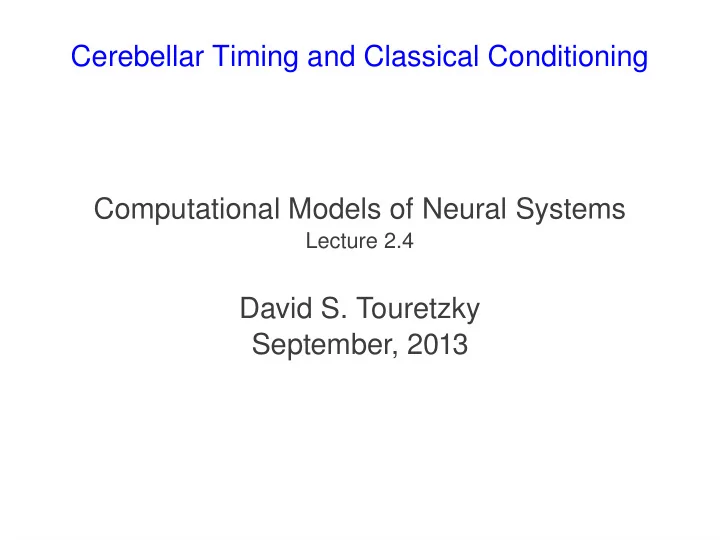

Cerebellar Timing and Classical Conditioning Computational Models of Neural Systems Lecture 2.4 David S. Touretzky September, 2013
Feedback vs. Feedforward Control Sensor input High latency Anticipatory response gives low latency Residual errors Better accuracy (lower error) Subject to oscillations if gain too high Sensors tell us the system state Control requires an internal model 2
Pavlovian Eyeblink Conditioning 3
Eyeblink Conditioning in Humans ● Measure cognitive development ● Impaired by mental disorders: ● Schizophrenia from San Diego Instruments ● OCD ● Fetal alchohol syndrome 4
Delay vs. Trace Conditioning ● Delay conditioning : CS stays on until US arrives CS US ● Trace conditioning : CS comes on and then goes off again. US must be associated with the memory trace of the CS. CS Trace US ● Trace conditioning takes about 5x as many trials to learn ● Trace conditioning (but not delay conditioning) is disrupted by lesions of hippocampus or medial prefrontal cortex. 5
Effect of Inter-Stimulus Interval (ISI) ● ISI must be 100-3000 msec (ideal is 200-500 msec) ● The learned CR (blink) is timed to just precede the UCS (air puff). ● Several hundred trials required for long ISIs ● Long ISIs also generate a broader response 6
7
Mixing 200 ms and 700 ms ISI Trials Two responses Two responses 8
Eyelid Conditioning Circuitry 9
Effects of Lesions ● Lesioning the cerebellar cortex disrupts response timing but does not abolish the response entirely. ● Associative learning can still occur, but responses have very short latency (timing is off). CS US ● Conclusion: two sites of Pavlovian learning in the cerebellum: – Interpositus nucleus learns to respond to the CS (mf → nuc) – Cerebellar cortex fine tunes the temporal response (pf → Pk) 10
Theories of Cerebellar Response Timing a) Delay lines b) Spectral timing c) Conjunctions of oscillators d) Liquid state machines 11
Medina & Mauk Simulation 600 mossy fibers 10,000 granule cells 900 Golgi cells 60 basket cells 20 Purkinje cells 6 nucleus cells > 300,000 synapses 12
13
More Simulation Details in the J.Neurosci. Paper Realistic mossy and climbing fiber inputs based on experimental data. 14
Response Timing in the Model 15
LTP + LTD ● Granule cells exhibit a granule cell responses variety of broad temporal responses ● LTD alone produces an overly broad CR (right). ● But LTP + LTD together produces a precisely timed response by combining inputs from multiple Purkinje cells to keep the DCN inhibited until just before the US is expected to arrive. 16
Time Course of Learning and Response Shaping Nuclear cell Simulated Purkinje cell Early LTP + Late LTD 17
Learning With LTP Disengaged: Response Timing is Poor 18
Recovery After Partial Lesion to Cerebellar Cortex 19
Recovery After Lesioning Cerebellar Cortex 20
Why Do Long ISIs Prevent Learning? Hypothesis: Too Much LTP Overwhelms LTD 21
Fiala et al. Spectral Timing Model Fiala, Grossberg, and Bullock, J. Neurosci. 16(11):3760-3774, 1996 Summary: there could be a set of delay lines built into every Purkinje cell's dendritic tree. 22
Metabolic Transmission Pathway in Purkinje Cell Dendrites DAG = diacylgycerol G = guanine nucleotide-binding protein mGluR1 = metab. glutamate receptor PKC = phospholipase C PIP 2 = phosphatidylinositol 4,5-biphosphate IP 3 = inositol 1,4,5-triphosphate, a second messenger IP 3 R = IP 3 receptor 23
Basic Story ● Glutamate binds to mGluR1 receptors, causing second messenger IP 3 to bind to IP 3 R receptor. ● IP 3 R receptor causes release of calcium from storage in the endoplasmic reticulum (ER). ● Ca 2+ activates calcium- dependent potassium channels, IP 3 R Open Probability hyperpolarizing the dendrite. ● When Ca 2+ concentration gets too high, the IP 3 R receptor closes again. 24
Spectral Timing ● Calcium level in the dendrite builds slowly as IP 3 accumulates. ● Positive feedback on IP 3 production and IP 3 R channel opening results in a rapid rise in calcium level. ● But when Ca 2+ level high enough, IP 3 R channels close again. ● The speed at which this happens depends on the number of mGluR1 receptors in the synapse. ● Different concentrations of mGluR1 receptors produce different timing characteristics. ● High calcium level hyperpolarizes the dendrite through calcium- dependent potassium channels and inhibits firing. 25
Spectral Timing: Calcium Concentration Profiles Fiala et al. simulation: responses to 50 msec glutamate application produced by varing B max parameter. 26
Learning Performance for the Model 30 trials; ISI = 500 msec 27
Learning in Purkinje Cell Dendrites LTP LTP LTD LTD 28
Cerebellar Cortex As a Liquid State Machine Yamazaki and Tanaka, Neural Networks ,20(3):290-297, April 2007 29
Rich Variety of Granule Cell Activity Patterns 30
Similarity Index: Granule Cell Activity Patterns Evolve Over Time Correlation of LSM activity patterns at times t 1 and t 2 . Slices through the graph at left at t=200, t=500, and t=800 show that similarity changes smoothly. 31
Cerebellum = Liquid State Machine + Perceptron 32
Summary ● Two sites of cerebellar learning for eyeblink conditioning: – Cells in interpositus nucleus learn to respond to tone CS – Purkinje cells in cerebellar cortex learn timing of the response ● Purkinje cells require both LTP and LTD to produce temporally accurate responses. ● Multiple hypotheses about how the cerebellum keeps time: delay lines, spectral timing, oscillators, liquid state machines ● Two hypotheses for why learning fails at long ISIs: – Medina et al: long period of LTP overwhelms LTD – Medina & Mauk recurrent network (= LSM) model: granule cell activity sequence gradually diverges 33
Recommend
More recommend